Economics Assignment: Comparing Monopoly & Competitive Markets
VerifiedAdded on 2023/06/15
|12
|1294
|481
Homework Assignment
AI Summary
This economics assignment provides a comprehensive analysis of monopoly and competitive market structures, focusing on key economic concepts such as total revenue, marginal revenue, total cost, consumer surplus, producer surplus, and deadweight loss. The assignment begins by determining the optimal price and output for a monopolist, calculating the monopoly profit, and assessing consumer and producer surplus under monopoly. It then contrasts these findings with a competitive market scenario, evaluating consumer and producer surplus under perfect competition. The analysis highlights the differences in market outcomes, particularly the higher consumer surplus in competitive markets and the higher producer surplus under monopoly. Finally, the assignment examines the concept of deadweight loss in a monopoly market, illustrating the inefficiency in resource allocation and the resulting welfare loss, and discusses the role of government intervention in natural monopolies to ensure efficient market outcomes.
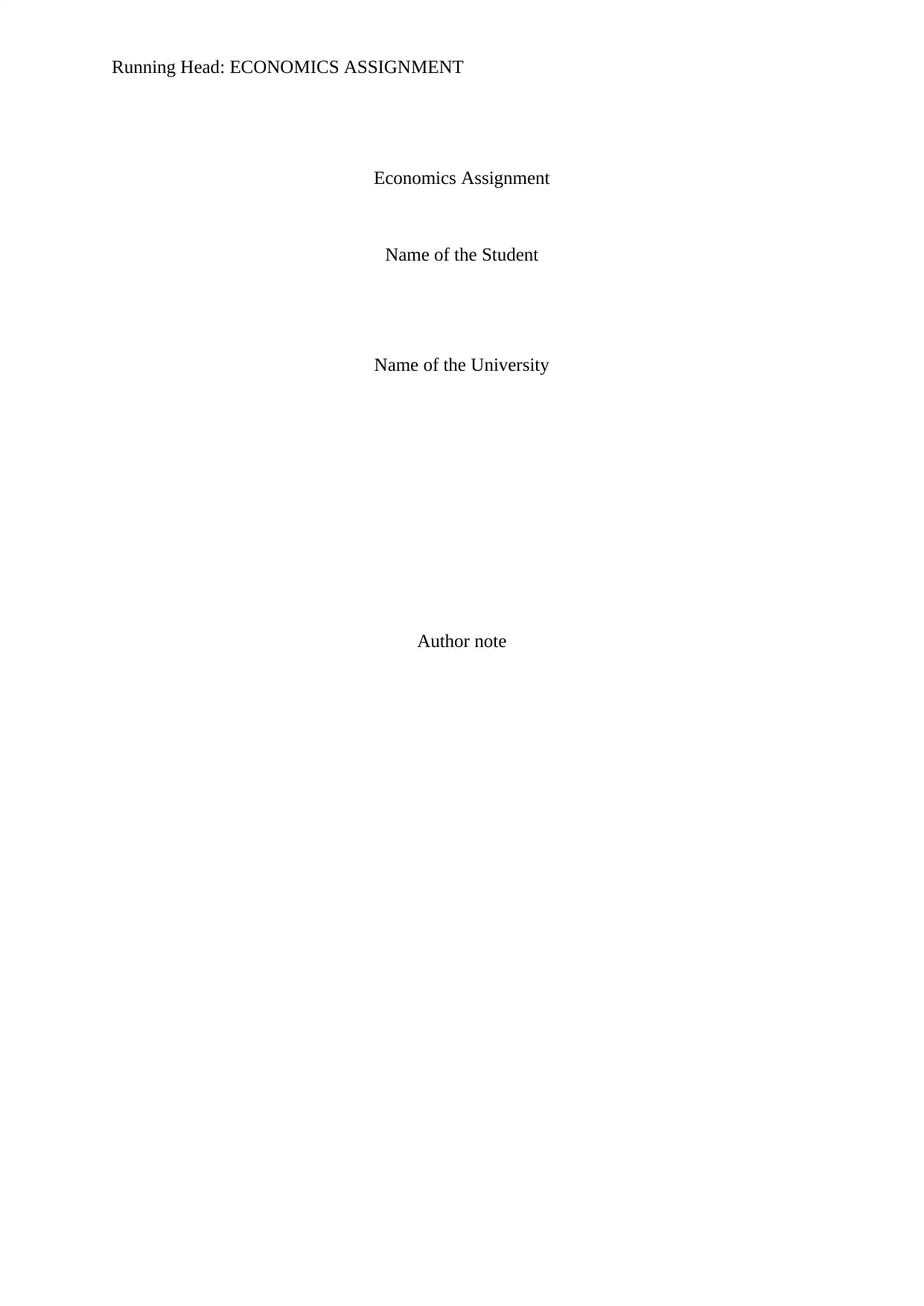
Running Head: ECONOMICS ASSIGNMENT
Economics Assignment
Name of the Student
Name of the University
Author note
Economics Assignment
Name of the Student
Name of the University
Author note
Paraphrase This Document
Need a fresh take? Get an instant paraphrase of this document with our AI Paraphraser
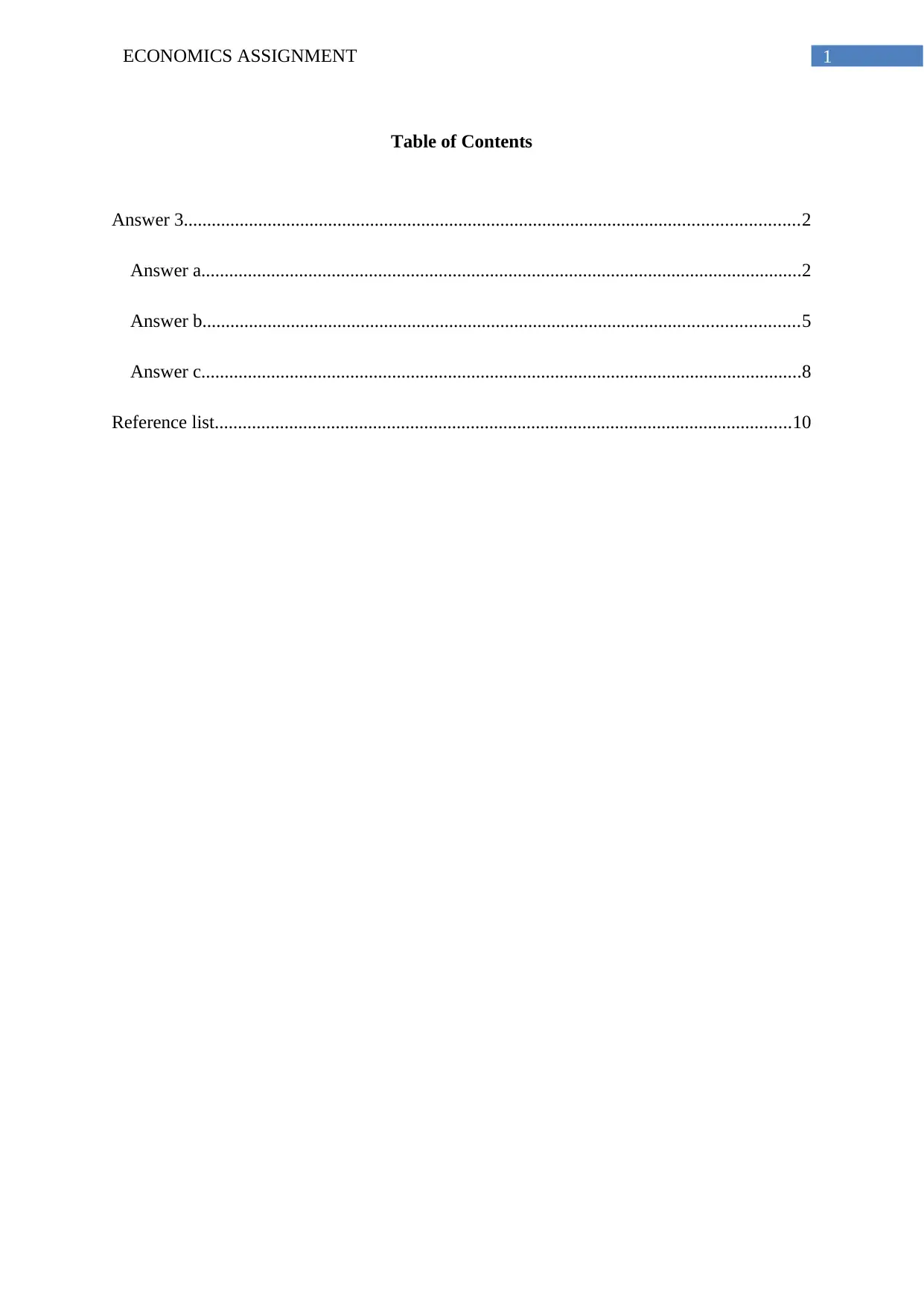
1ECONOMICS ASSIGNMENT
Table of Contents
Answer 3....................................................................................................................................2
Answer a.................................................................................................................................2
Answer b................................................................................................................................5
Answer c.................................................................................................................................8
Reference list............................................................................................................................10
Table of Contents
Answer 3....................................................................................................................................2
Answer a.................................................................................................................................2
Answer b................................................................................................................................5
Answer c.................................................................................................................................8
Reference list............................................................................................................................10
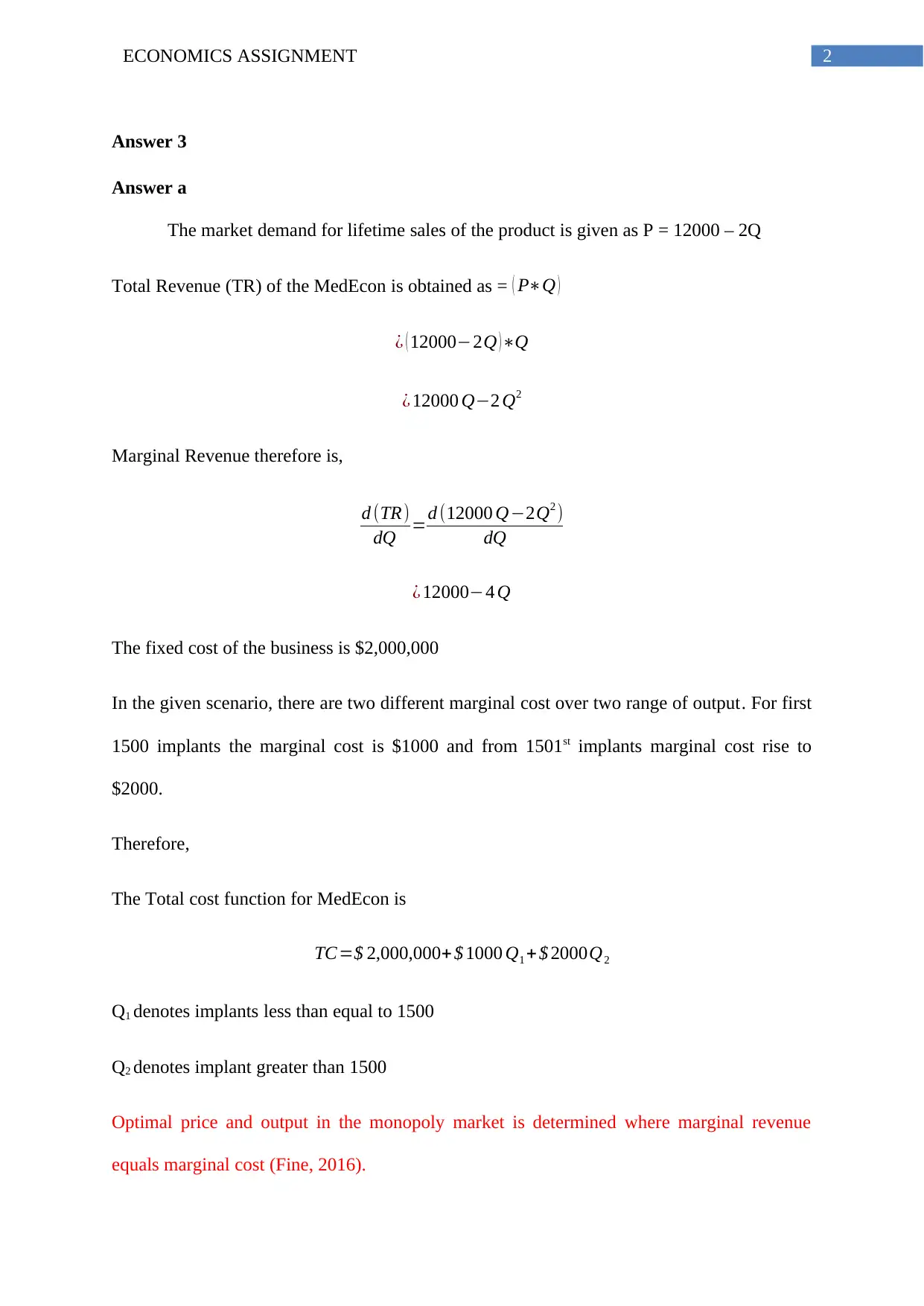
2ECONOMICS ASSIGNMENT
Answer 3
Answer a
The market demand for lifetime sales of the product is given as P = 12000 – 2Q
Total Revenue (TR) of the MedEcon is obtained as = ( P∗Q )
¿ ( 12000−2Q )∗Q
¿ 12000 Q−2 Q2
Marginal Revenue therefore is,
d (TR)
dQ =d (12000 Q−2Q2 )
dQ
¿ 12000−4 Q
The fixed cost of the business is $2,000,000
In the given scenario, there are two different marginal cost over two range of output. For first
1500 implants the marginal cost is $1000 and from 1501st implants marginal cost rise to
$2000.
Therefore,
The Total cost function for MedEcon is
TC=$ 2,000,000+$ 1000 Q1 + $ 2000Q2
Q1 denotes implants less than equal to 1500
Q2 denotes implant greater than 1500
Optimal price and output in the monopoly market is determined where marginal revenue
equals marginal cost (Fine, 2016).
Answer 3
Answer a
The market demand for lifetime sales of the product is given as P = 12000 – 2Q
Total Revenue (TR) of the MedEcon is obtained as = ( P∗Q )
¿ ( 12000−2Q )∗Q
¿ 12000 Q−2 Q2
Marginal Revenue therefore is,
d (TR)
dQ =d (12000 Q−2Q2 )
dQ
¿ 12000−4 Q
The fixed cost of the business is $2,000,000
In the given scenario, there are two different marginal cost over two range of output. For first
1500 implants the marginal cost is $1000 and from 1501st implants marginal cost rise to
$2000.
Therefore,
The Total cost function for MedEcon is
TC=$ 2,000,000+$ 1000 Q1 + $ 2000Q2
Q1 denotes implants less than equal to 1500
Q2 denotes implant greater than 1500
Optimal price and output in the monopoly market is determined where marginal revenue
equals marginal cost (Fine, 2016).
⊘ This is a preview!⊘
Do you want full access?
Subscribe today to unlock all pages.

Trusted by 1+ million students worldwide
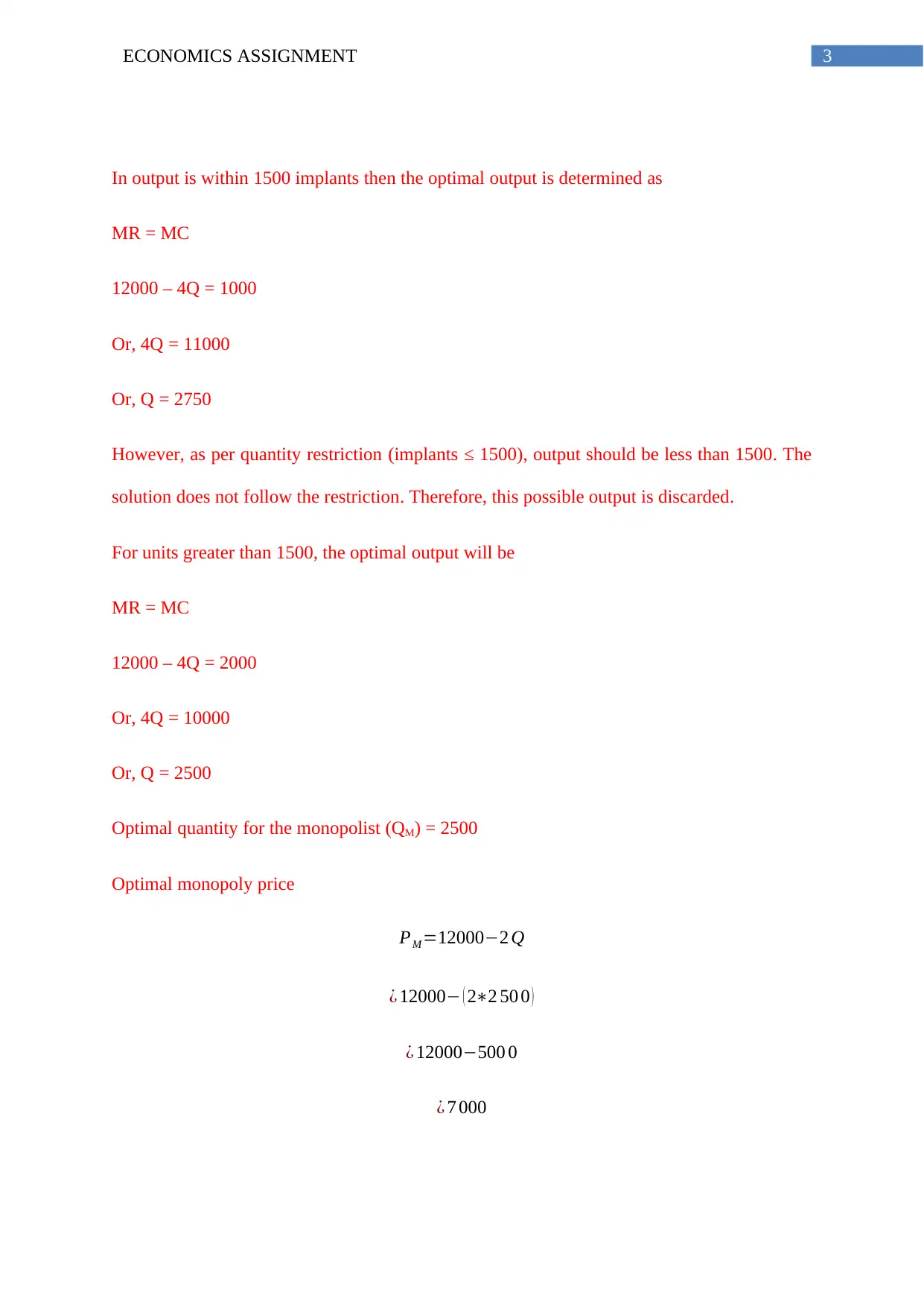
3ECONOMICS ASSIGNMENT
In output is within 1500 implants then the optimal output is determined as
MR = MC
12000 – 4Q = 1000
Or, 4Q = 11000
Or, Q = 2750
However, as per quantity restriction (implants ≤ 1500), output should be less than 1500. The
solution does not follow the restriction. Therefore, this possible output is discarded.
For units greater than 1500, the optimal output will be
MR = MC
12000 – 4Q = 2000
Or, 4Q = 10000
Or, Q = 2500
Optimal quantity for the monopolist (QM) = 2500
Optimal monopoly price
PM =12000−2 Q
¿ 12000− ( 2∗2 50 0 )
¿ 12000−500 0
¿ 7 000
In output is within 1500 implants then the optimal output is determined as
MR = MC
12000 – 4Q = 1000
Or, 4Q = 11000
Or, Q = 2750
However, as per quantity restriction (implants ≤ 1500), output should be less than 1500. The
solution does not follow the restriction. Therefore, this possible output is discarded.
For units greater than 1500, the optimal output will be
MR = MC
12000 – 4Q = 2000
Or, 4Q = 10000
Or, Q = 2500
Optimal quantity for the monopolist (QM) = 2500
Optimal monopoly price
PM =12000−2 Q
¿ 12000− ( 2∗2 50 0 )
¿ 12000−500 0
¿ 7 000
Paraphrase This Document
Need a fresh take? Get an instant paraphrase of this document with our AI Paraphraser
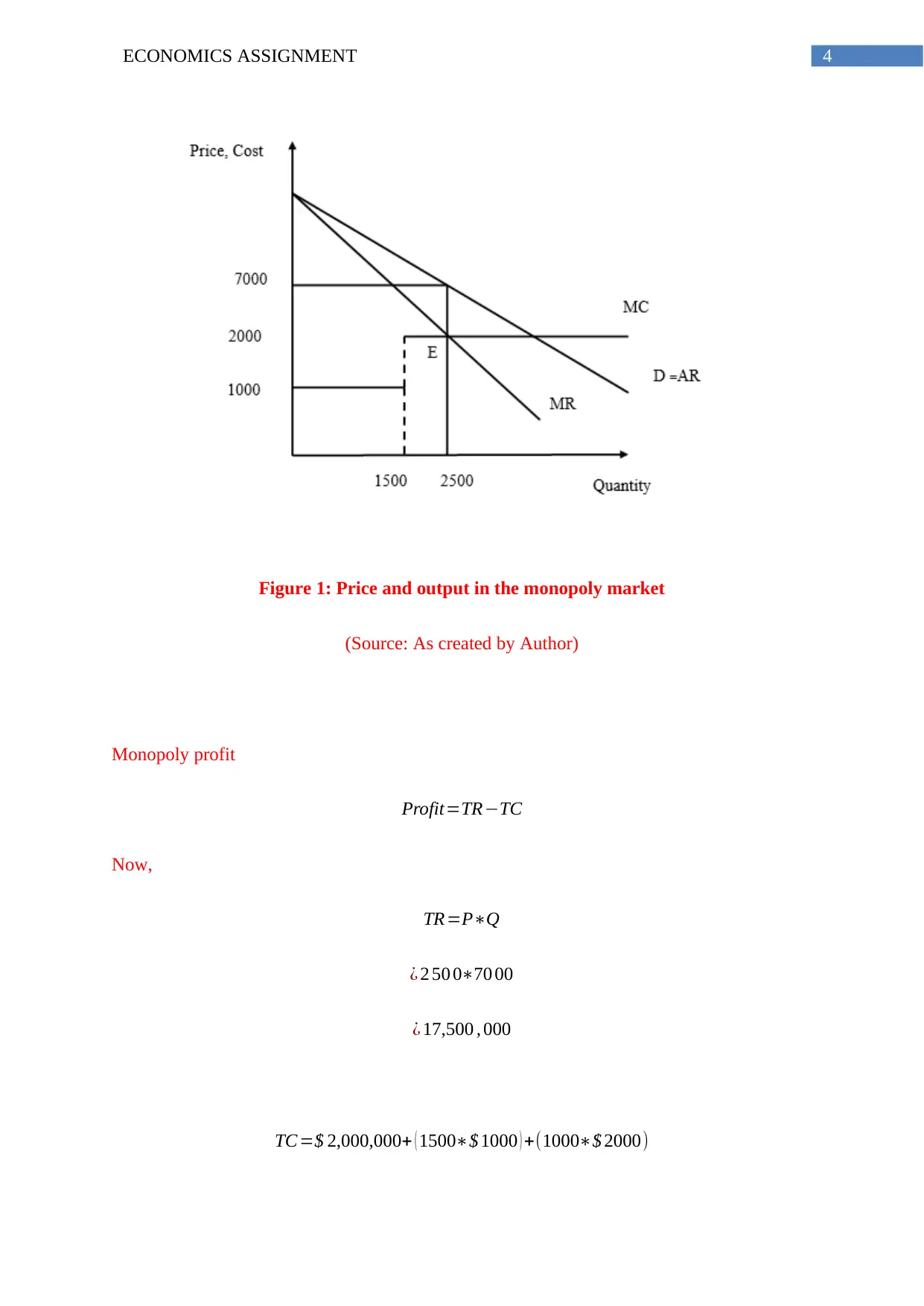
4ECONOMICS ASSIGNMENT
Figure 1: Price and output in the monopoly market
(Source: As created by Author)
Monopoly profit
Profit=TR−TC
Now,
TR=P∗Q
¿ 2 50 0∗70 00
¿ 17,500 , 000
TC =$ 2,000,000+ ( 1500∗$ 1000 ) +(1000∗$ 2000)
Figure 1: Price and output in the monopoly market
(Source: As created by Author)
Monopoly profit
Profit=TR−TC
Now,
TR=P∗Q
¿ 2 50 0∗70 00
¿ 17,500 , 000
TC =$ 2,000,000+ ( 1500∗$ 1000 ) +(1000∗$ 2000)
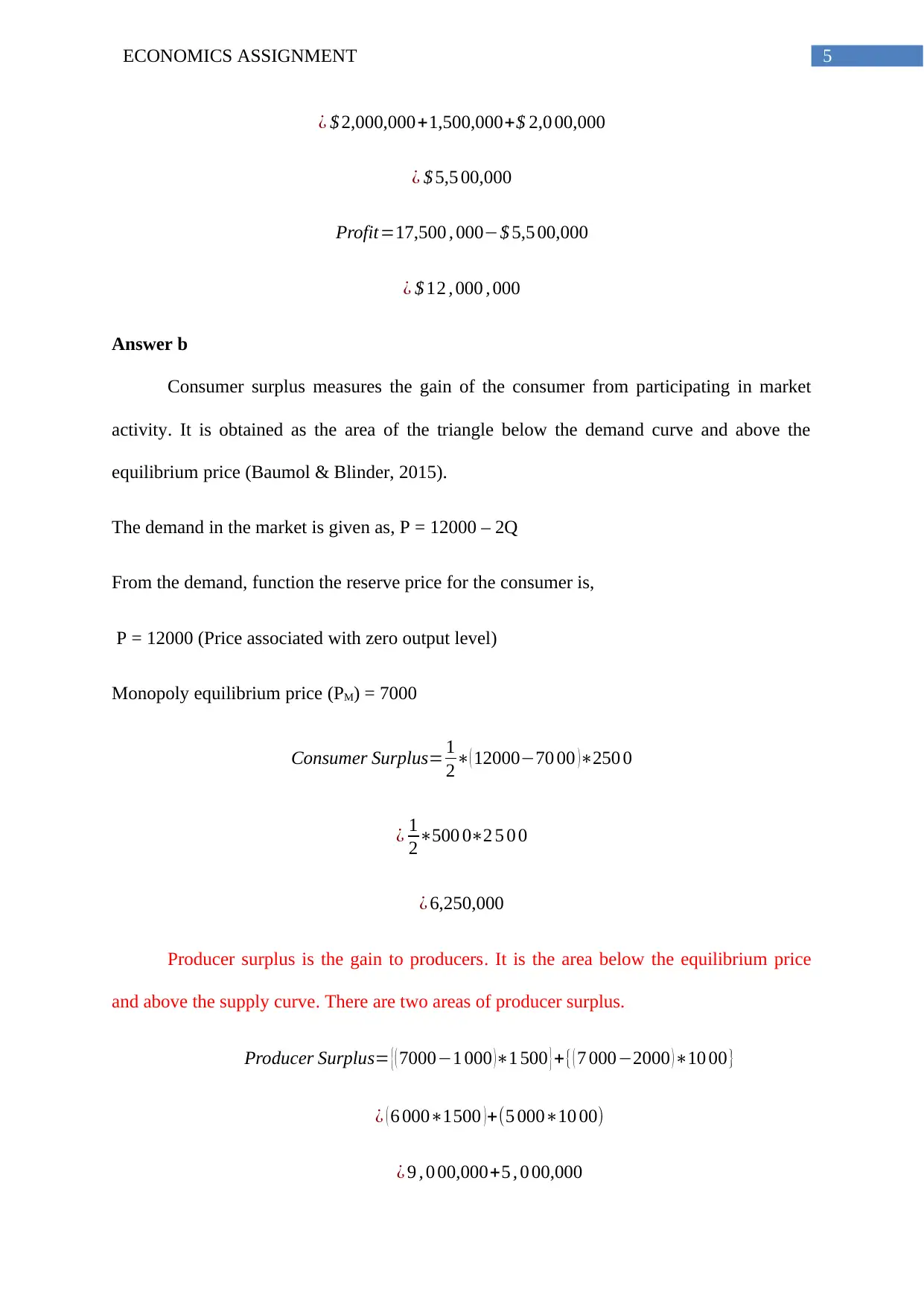
5ECONOMICS ASSIGNMENT
¿ $ 2,000,000+1,500,000+$ 2,0 00,000
¿ $ 5,5 00,000
Profit=17,500 , 000−$ 5,5 00,000
¿ $ 12 , 000 , 000
Answer b
Consumer surplus measures the gain of the consumer from participating in market
activity. It is obtained as the area of the triangle below the demand curve and above the
equilibrium price (Baumol & Blinder, 2015).
The demand in the market is given as, P = 12000 – 2Q
From the demand, function the reserve price for the consumer is,
P = 12000 (Price associated with zero output level)
Monopoly equilibrium price (PM) = 7000
Consumer Surplus= 1
2∗( 12000−70 00 )∗250 0
¿ 1
2∗500 0∗2 5 0 0
¿ 6,250,000
Producer surplus is the gain to producers. It is the area below the equilibrium price
and above the supply curve. There are two areas of producer surplus.
Producer Surplus= {( 7000−1 000 )∗1 500 } +{( 7 000−2000 ) ∗10 00}
¿ ( 6 000∗1500 )+(5 000∗10 00)
¿ 9 , 0 00,000+5 , 0 00,000
¿ $ 2,000,000+1,500,000+$ 2,0 00,000
¿ $ 5,5 00,000
Profit=17,500 , 000−$ 5,5 00,000
¿ $ 12 , 000 , 000
Answer b
Consumer surplus measures the gain of the consumer from participating in market
activity. It is obtained as the area of the triangle below the demand curve and above the
equilibrium price (Baumol & Blinder, 2015).
The demand in the market is given as, P = 12000 – 2Q
From the demand, function the reserve price for the consumer is,
P = 12000 (Price associated with zero output level)
Monopoly equilibrium price (PM) = 7000
Consumer Surplus= 1
2∗( 12000−70 00 )∗250 0
¿ 1
2∗500 0∗2 5 0 0
¿ 6,250,000
Producer surplus is the gain to producers. It is the area below the equilibrium price
and above the supply curve. There are two areas of producer surplus.
Producer Surplus= {( 7000−1 000 )∗1 500 } +{( 7 000−2000 ) ∗10 00}
¿ ( 6 000∗1500 )+(5 000∗10 00)
¿ 9 , 0 00,000+5 , 0 00,000
⊘ This is a preview!⊘
Do you want full access?
Subscribe today to unlock all pages.

Trusted by 1+ million students worldwide
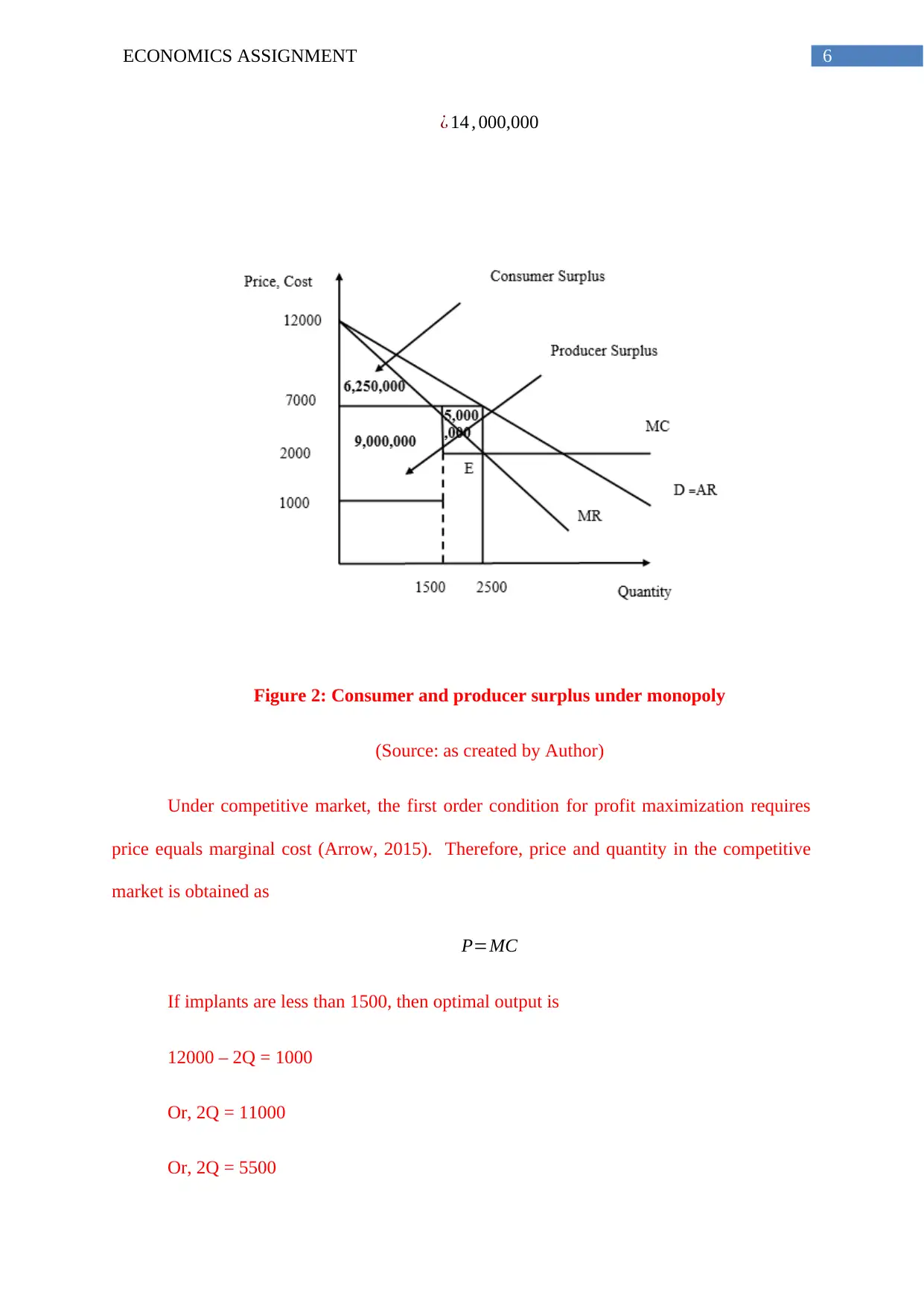
6ECONOMICS ASSIGNMENT
¿ 14 , 000,000
Figure 2: Consumer and producer surplus under monopoly
(Source: as created by Author)
Under competitive market, the first order condition for profit maximization requires
price equals marginal cost (Arrow, 2015). Therefore, price and quantity in the competitive
market is obtained as
P=MC
If implants are less than 1500, then optimal output is
12000 – 2Q = 1000
Or, 2Q = 11000
Or, 2Q = 5500
¿ 14 , 000,000
Figure 2: Consumer and producer surplus under monopoly
(Source: as created by Author)
Under competitive market, the first order condition for profit maximization requires
price equals marginal cost (Arrow, 2015). Therefore, price and quantity in the competitive
market is obtained as
P=MC
If implants are less than 1500, then optimal output is
12000 – 2Q = 1000
Or, 2Q = 11000
Or, 2Q = 5500
Paraphrase This Document
Need a fresh take? Get an instant paraphrase of this document with our AI Paraphraser
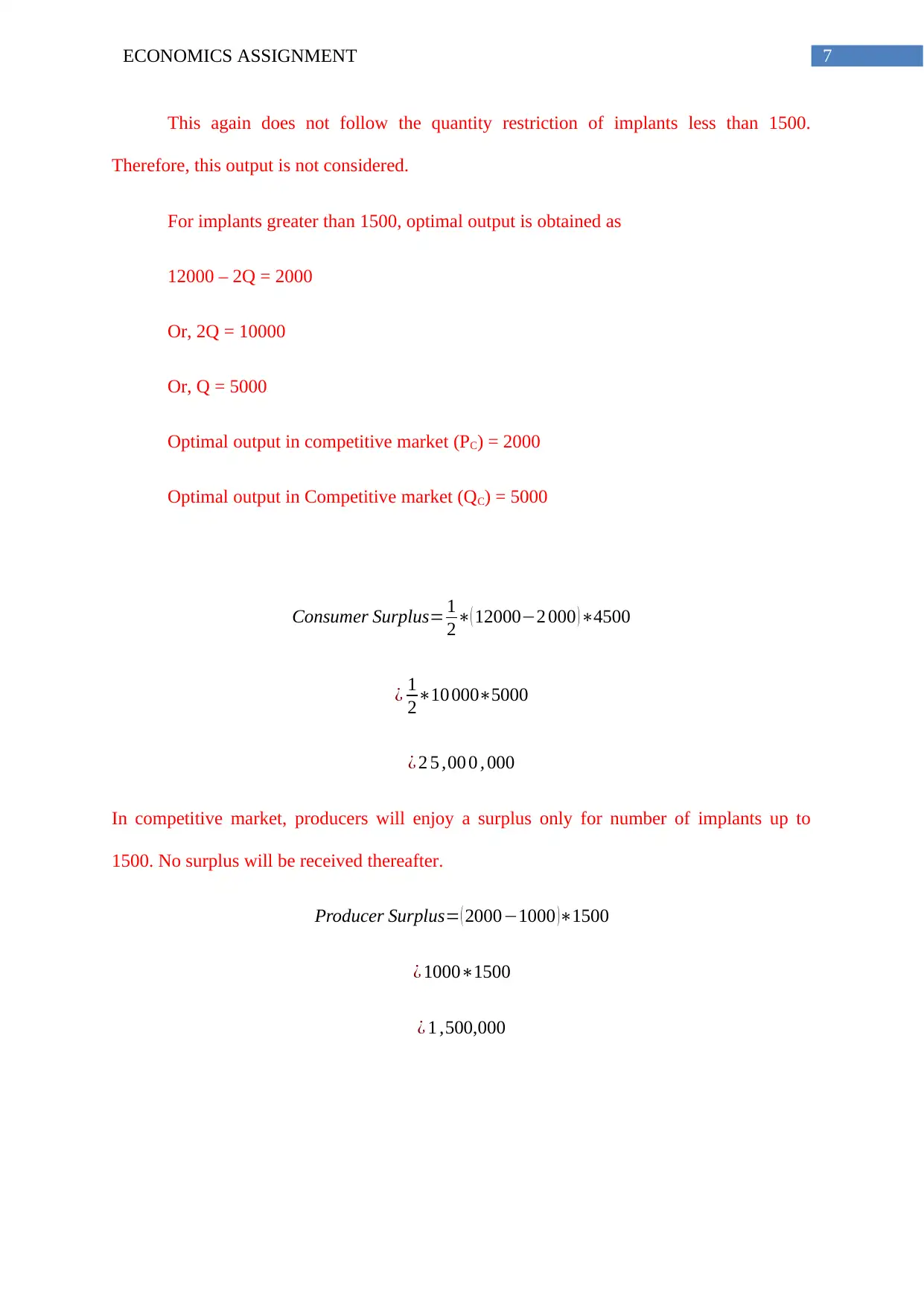
7ECONOMICS ASSIGNMENT
This again does not follow the quantity restriction of implants less than 1500.
Therefore, this output is not considered.
For implants greater than 1500, optimal output is obtained as
12000 – 2Q = 2000
Or, 2Q = 10000
Or, Q = 5000
Optimal output in competitive market (PC) = 2000
Optimal output in Competitive market (QC) = 5000
Consumer Surplus= 1
2∗( 12000−2 000 )∗4500
¿ 1
2∗10 000∗5000
¿ 2 5 ,00 0 , 000
In competitive market, producers will enjoy a surplus only for number of implants up to
1500. No surplus will be received thereafter.
Producer Surplus= ( 2000−1000 )∗1500
¿ 1000∗1500
¿ 1 ,500,000
This again does not follow the quantity restriction of implants less than 1500.
Therefore, this output is not considered.
For implants greater than 1500, optimal output is obtained as
12000 – 2Q = 2000
Or, 2Q = 10000
Or, Q = 5000
Optimal output in competitive market (PC) = 2000
Optimal output in Competitive market (QC) = 5000
Consumer Surplus= 1
2∗( 12000−2 000 )∗4500
¿ 1
2∗10 000∗5000
¿ 2 5 ,00 0 , 000
In competitive market, producers will enjoy a surplus only for number of implants up to
1500. No surplus will be received thereafter.
Producer Surplus= ( 2000−1000 )∗1500
¿ 1000∗1500
¿ 1 ,500,000
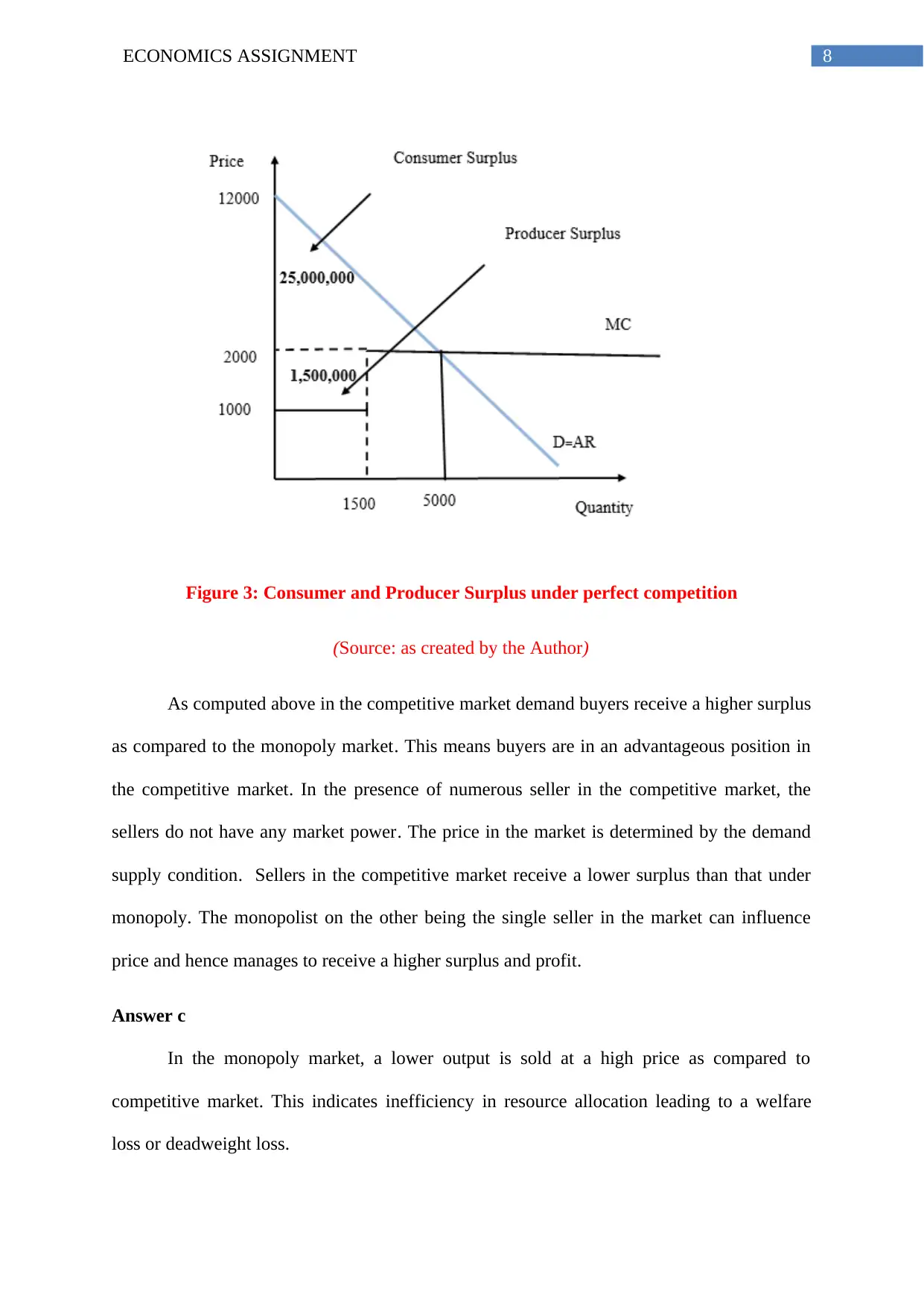
8ECONOMICS ASSIGNMENT
Figure 3: Consumer and Producer Surplus under perfect competition
(Source: as created by the Author)
As computed above in the competitive market demand buyers receive a higher surplus
as compared to the monopoly market. This means buyers are in an advantageous position in
the competitive market. In the presence of numerous seller in the competitive market, the
sellers do not have any market power. The price in the market is determined by the demand
supply condition. Sellers in the competitive market receive a lower surplus than that under
monopoly. The monopolist on the other being the single seller in the market can influence
price and hence manages to receive a higher surplus and profit.
Answer c
In the monopoly market, a lower output is sold at a high price as compared to
competitive market. This indicates inefficiency in resource allocation leading to a welfare
loss or deadweight loss.
Figure 3: Consumer and Producer Surplus under perfect competition
(Source: as created by the Author)
As computed above in the competitive market demand buyers receive a higher surplus
as compared to the monopoly market. This means buyers are in an advantageous position in
the competitive market. In the presence of numerous seller in the competitive market, the
sellers do not have any market power. The price in the market is determined by the demand
supply condition. Sellers in the competitive market receive a lower surplus than that under
monopoly. The monopolist on the other being the single seller in the market can influence
price and hence manages to receive a higher surplus and profit.
Answer c
In the monopoly market, a lower output is sold at a high price as compared to
competitive market. This indicates inefficiency in resource allocation leading to a welfare
loss or deadweight loss.
⊘ This is a preview!⊘
Do you want full access?
Subscribe today to unlock all pages.

Trusted by 1+ million students worldwide

9ECONOMICS ASSIGNMENT
Deadweig h t loss= 1
2∗( Qc−QM )∗(PM−PC )
¿ 1
2∗( 500 0−2 50 0 )∗(70 00−2000)
¿ 1
2∗250 0∗500 0
¿ 6 , 25 0 , 000
Figure 4: Comparison of monopoly and competitive market
(Source: as created by Author)
As show above in a pure monopoly market, there is a deadweight loss indicating net
loss in social welfare. The dead weight loss arises because the monopolist offers a lower
quantity at a high price. This reduces consumer surplus. However, all the lost consumer
surplus does not add to the producer loss leading to efficiency loss. Under this circumstance,
it might be recommended for government to eliminate monopolized market. However, there
Deadweig h t loss= 1
2∗( Qc−QM )∗(PM−PC )
¿ 1
2∗( 500 0−2 50 0 )∗(70 00−2000)
¿ 1
2∗250 0∗500 0
¿ 6 , 25 0 , 000
Figure 4: Comparison of monopoly and competitive market
(Source: as created by Author)
As show above in a pure monopoly market, there is a deadweight loss indicating net
loss in social welfare. The dead weight loss arises because the monopolist offers a lower
quantity at a high price. This reduces consumer surplus. However, all the lost consumer
surplus does not add to the producer loss leading to efficiency loss. Under this circumstance,
it might be recommended for government to eliminate monopolized market. However, there
Paraphrase This Document
Need a fresh take? Get an instant paraphrase of this document with our AI Paraphraser

10ECONOMICS ASSIGNMENT
is situation where only a single seller can serve the market in the most efficient way. Here,
the government should encourage monopoly market. In this form of market, usually a high
fixed cost is present. The single monopolist enjoys benefit of economies of scale and serve
the market efficiently. This type of market is called natural monopoly (Mahanty, 2014).
Public utilities such as electricity, water supply are examples of natural monopoly market.
is situation where only a single seller can serve the market in the most efficient way. Here,
the government should encourage monopoly market. In this form of market, usually a high
fixed cost is present. The single monopolist enjoys benefit of economies of scale and serve
the market efficiently. This type of market is called natural monopoly (Mahanty, 2014).
Public utilities such as electricity, water supply are examples of natural monopoly market.
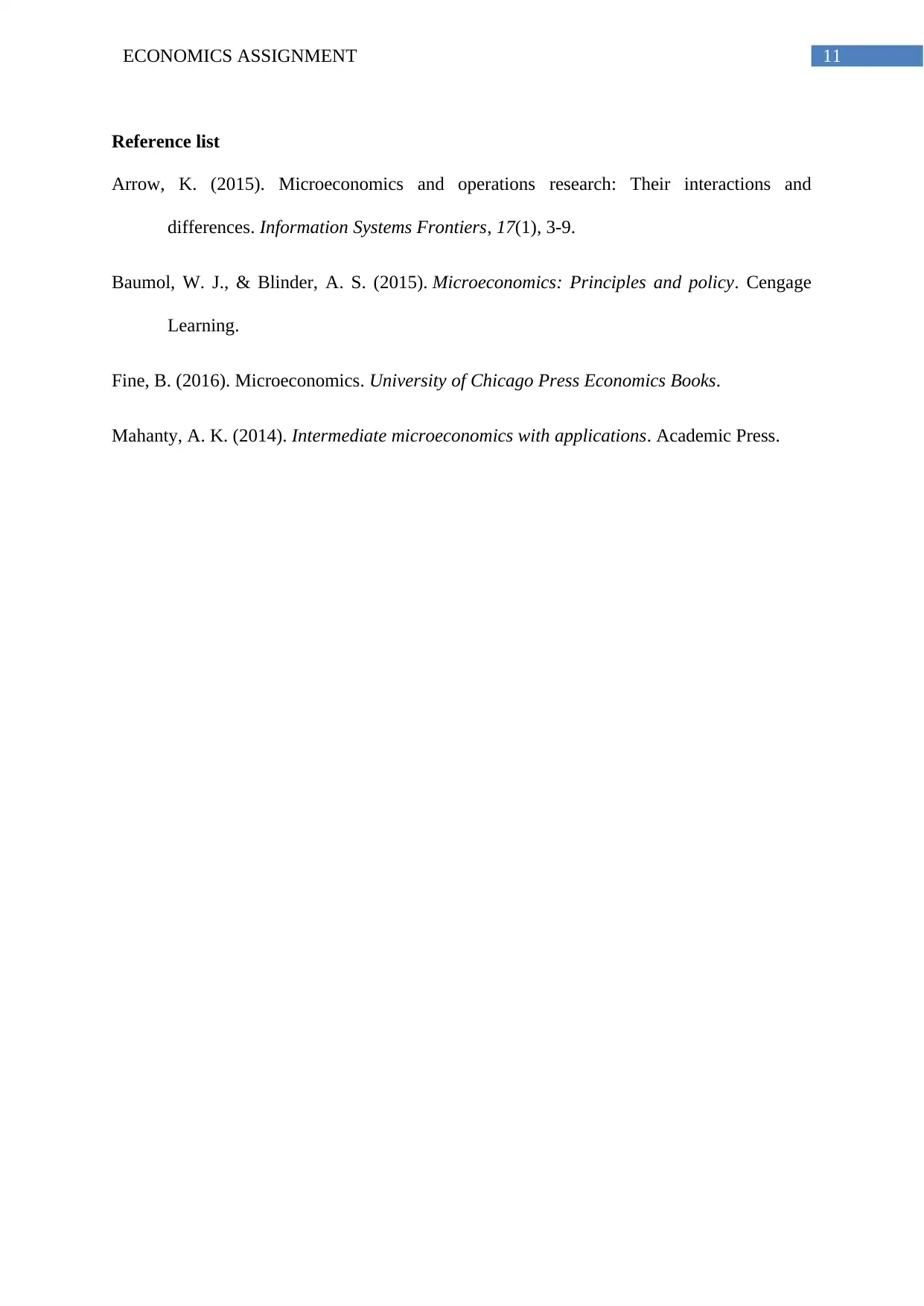
11ECONOMICS ASSIGNMENT
Reference list
Arrow, K. (2015). Microeconomics and operations research: Their interactions and
differences. Information Systems Frontiers, 17(1), 3-9.
Baumol, W. J., & Blinder, A. S. (2015). Microeconomics: Principles and policy. Cengage
Learning.
Fine, B. (2016). Microeconomics. University of Chicago Press Economics Books.
Mahanty, A. K. (2014). Intermediate microeconomics with applications. Academic Press.
Reference list
Arrow, K. (2015). Microeconomics and operations research: Their interactions and
differences. Information Systems Frontiers, 17(1), 3-9.
Baumol, W. J., & Blinder, A. S. (2015). Microeconomics: Principles and policy. Cengage
Learning.
Fine, B. (2016). Microeconomics. University of Chicago Press Economics Books.
Mahanty, A. K. (2014). Intermediate microeconomics with applications. Academic Press.
⊘ This is a preview!⊘
Do you want full access?
Subscribe today to unlock all pages.

Trusted by 1+ million students worldwide
1 out of 12
Related Documents
Your All-in-One AI-Powered Toolkit for Academic Success.
+13062052269
info@desklib.com
Available 24*7 on WhatsApp / Email
![[object Object]](/_next/static/media/star-bottom.7253800d.svg)
Unlock your academic potential
Copyright © 2020–2025 A2Z Services. All Rights Reserved. Developed and managed by ZUCOL.


